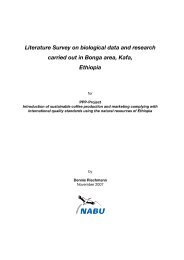Flora Biodiversity Assessment in Bonga, Boginda and Mankira Forest
Flora Biodiversity Assessment in Bonga, Boginda and Mankira Forest
Flora Biodiversity Assessment in Bonga, Boginda and Mankira Forest
Create successful ePaper yourself
Turn your PDF publications into a flip-book with our unique Google optimized e-Paper software.
e undertaken <strong>in</strong> the area, so that appropriate (i.e. socially accepted <strong>and</strong><br />
environmentally sound) measures may be taken. The exist<strong>in</strong>g PFM program<br />
needs to be strengthened.<br />
C. Five frequency classes are recognized <strong>and</strong> shown <strong>in</strong> the follow<strong>in</strong>g Table.<br />
Lamprecht, 1989 has <strong>in</strong>dicated as it is customary practice to assign the various<br />
species to five classes based on their absolute 8 frequencies <strong>and</strong> depicted as follows<br />
(Table 8):<br />
Table 8. Frequency class of tree/shrub/lianas species <strong>in</strong> the study area<br />
Class Absolute Frequency Presence 9<br />
A=I 1-20 Rare<br />
B=II 21-40 Seldom Present<br />
C=III 41-60 Often present<br />
D=IV 61-80 Mostly present<br />
E=V 81-100 Constantly Present<br />
Accord<strong>in</strong>gly, all the species registered <strong>in</strong> the three forests are grouped <strong>in</strong> this<br />
category to see whether each forest is heterogeneous or homogeneous. Lamprecht,<br />
1989 <strong>in</strong>dicated that diagrams with high values <strong>in</strong> D/E <strong>and</strong> low values <strong>in</strong> A/B <strong>in</strong>dicate<br />
constant or similar tree species composition (homogeneous). A high degree of<br />
floristic heterogeneity is found when the situation is reversed i.e. when the values of<br />
D/E are low <strong>and</strong> the values of A/B are high.<br />
The follow<strong>in</strong>g Table <strong>and</strong> figure are the result of the current survey. High values <strong>in</strong> the<br />
three forests are <strong>in</strong> A/B. Hence it can be concluded that the forests’ floristic<br />
composition with regard to trees/shrubs <strong>and</strong> lianas greater than 10 cm are<br />
heterogeneous. Getachew Berhane <strong>and</strong> Yoseph Assefa <strong>in</strong> IBC, 2002 got similar result<br />
for Bog<strong>in</strong>da forest.<br />
8 Expressed as percentage<br />
9 Based on Lecture note on “General Ecology”, Wondogenet College of <strong>Forest</strong>ry.<br />
51



